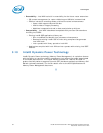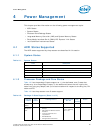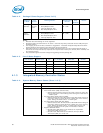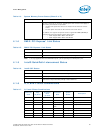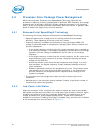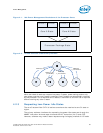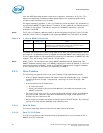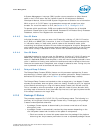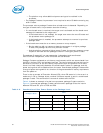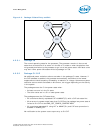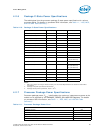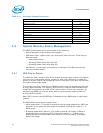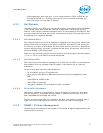
Power Management
92 Intel® Xeon® Processor E5-1600 v2/E5-2600 v2 Product Families
Datasheet Volume One of Two
— The platform may allow additional power savings to be realized in the
processor.
• For package C-states, the processor is not required to enter C0 before entering any
other C-state.
The processor exits a package C-state when a break event is detected. Depending on
the type of break event, the processor does the following:
• If a core break event is received, the target core is activated and the break event
message is forwarded to the target core.
— If the break event is not masked, the target core enters the core C0 state and
the processor enters package C0.
— If the break event is masked, the processor attempts to re-enter its previous
package state.
• If the break event was due to a memory access or snoop request.
— But the platform did not request to keep the processor in a higher package
C-state, the package returns to its previous C-state.
— And the platform requests a higher power C-state, the memory access or snoop
request is serviced and the package remains in the higher power C-state.
The package C-states fall into two categories: independent and coordinated.
C0/C1/C1E are independent, while C2/C3/C6 are coordinated.
Package C-states are based on exit latency requirements which are accumulated from
the PCIe* devices, PCH, and software sources. The level of power savings that can be
achieved is a function of the exit latency requirement from the platform. As a result,
there is no fixed relationship between the coordinated C-state of a package, and the
power savings that will be obtained from the state. Coordinated package C-states offer
a range of power savings which is a function of the guaranteed exit latency requirement
from the platform.
There is also a concept of Execution Allowed (EA), when EA status is 0, the cores in a
socket are in C3 or a deeper state, a socket initiates a request to enter a coordinated
package C-state. The coordination is across all sockets and the PCH.
Table 4-9 shows an example of a dual-core processor package C-state resolution.
Figure 4-3 summarizes package C-state transitions with package C2 as the interim
between PC0 and PC1 prior to PC3 and PC6.
Table 4-9. Coordination of Core Power States at the Package Level
Package C-State
Core 1
C0 C1 C3 C6
Core 0
C0
C0 C0 C0 C0
C1
C0 C1
1
1. The package C-state will be C1E if all actives cores have resolved a core C1 state or higher.
C1
1
C1
1
C3
C0 C1
1
C3 C3
C6
C0 C1
1
C3 C6



